Have You Heard of Gyor, a Lovely Place in Hungary?
- Pinterest1.1K
- Facebook522
- Twitter4
- Reddit0
- Flipboard1
- Email4
- Buffer15
- 1.7Kshares
- Like
- Digg
- Del
- Tumblr
- VKontakte
- Buffer
- Love This
- Odnoklassniki
- Meneame
- Blogger
- Amazon
- Yahoo Mail
- Gmail
- AOL
- Newsvine
- HackerNews
- Evernote
- MySpace
- Mail.ru
- Viadeo
- Line
- Comments
- Yummly
- SMS
- Viber
- Telegram
- Subscribe
- Skype
- Facebook Messenger
- Kakao
- LiveJournal
- Yammer
- Edgar
- Fintel
- Mix
- Instapaper
- Copy Link
Don’t you love it when you come to a town or city, without any preconceived ideas or expectations, and the place just enthrals you? This happened to both of us in Győr (or Gyor for those without special characters on their keyboard) – a lovely medium sized city in Hungary. It isn’t a famous tourist destination and doesn’t have any really spectacular sights, but there is enough to see and do in Györ to make any visitor happy.
![We show you all the things to see in Győr, a lovely place in Hungary. This city surprised us with its mostly Baroque centre, cleanliness and relaxed feel. [Photo shows the Bishops Palace from the bridge across the river Rába - with title text on top.]](https://dare2go.com/travel/wp-content/uploads/2019/10/Gyor-Hungary-featured.jpg)
We show you all the things to see in Győr, a lovely place in Hungary. This city surprised us with its mostly Baroque centre, cleanliness and relaxed feel.
What you will find in this article:
The best aspects about Győr (pronounced jyeur) are that
- it is not overrun by tourists, rather the opposite
- it’s a friendly town, full of life but not overly busy
- the town centre is fairly compact and rather picturesque
- it’s easy to get around (and find parking)
- it’s clean, pedestrian friendly, and offers a lot of outdoor cafes and restaurants
- all main sights of Győr are within easy walking distance
- everywhere you go you can buy a yummy cone of icecream
This book is for travellers who are more interested in the sights than recommendations for restaurants or hotels.
A Brief History of Gyor
Its location at the confluence of 4 main rivers (the Danube, Mosoni-Duna, Rába, and Rábca) is of historic importance to the city of Gyor and made it an attractive place to settle early in history. The oldest recorded settlers were Celts around the 5th century BC. They called the town Ara Bona (Good Altar), later contracted to Arrabona under the Romans, which is kept alive in the German name for the city, Raab, and the name of the thermal baths in Gyor.
The Danube has been a major trading route for centuries. Many towns along its banks prospered from trade – as did Gyor. That’s why today you will find numerous stately Baroque buildings in the centre of the old town. For more about the city’s history please refer to Wikipedia . Or read through our descriptions of individual buildings – you will discover some truly quirky historic tales of this city!

You might wonder why many of our photos of the Széchenyi Square show large glossy black panels with photos. The Hungarian wildlife photographer Bence Máté had a temporary exhibition and sales pavillion on the square. Not only children were fascinated by his images – we were too!
17 Things To Do and See in Gyor
The town doesn’t have a typical medieval centre with narrow cobbled streets and crooked half-timbered houses. Instead, most streets are laid out in a grid with generous open spaces. That’s because Kristóf Lamberg, Gyor’s commander in 1529, decided ‘in his wisdom’ to torch the entire city, instead of having it fall into the hands of the invading Turks. What you see today was mostly built from the 17th century onwards – although some remains of the town wall date back to Roman times.
One of the city’s slogans is “City of Water”, and it’s no wonder since it’s surrounded by rivers. Gyor carries water as a central theme throughout, from its numerous public artworks (most sculptures feature water in one form or another) to its leisure activities. Where we parked overnight, at a sidearm of a river, canoeing was a very popular sport for the younger ones and more leisurely fishing for the older. In summer, the city installs an 800m wake-boarding course.
The New City Hall
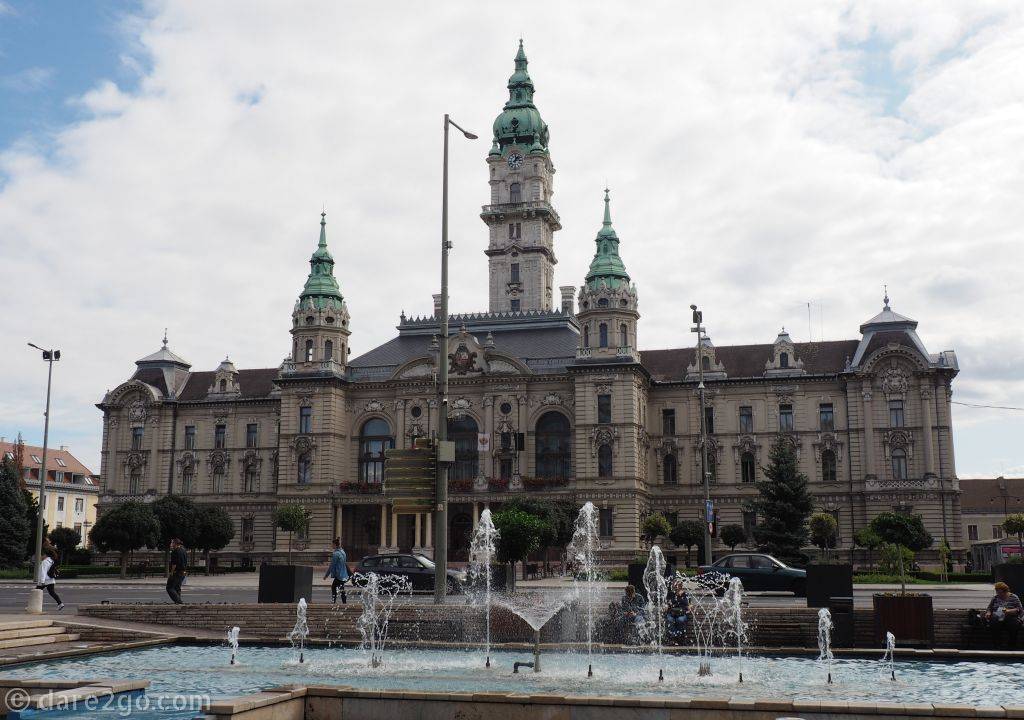
Győr’s large New City Hall dominates the square at one end of the city. In the foreground another of the town’s many fountains.
This icon of the town dominates a large square at the southern end of the pedestrian zone. Although it’s an imposing building in size, the facade has very pleasant proportions. The bells on the central clock tower play a popular folk music tune every full hour. The New City Hall was inaugurated in 1900. In the small park across from it, you will find one of many fountains of Gyor.
Right behind the New City Hall are the train and the bus stations. If you arrive by public transport this might be your first sight. The town’s Tourist Information Office in located half way down the pedestrian zone, which is across the road from the City Hall, at Baross Gábor út 21.
The Benedict Buildings
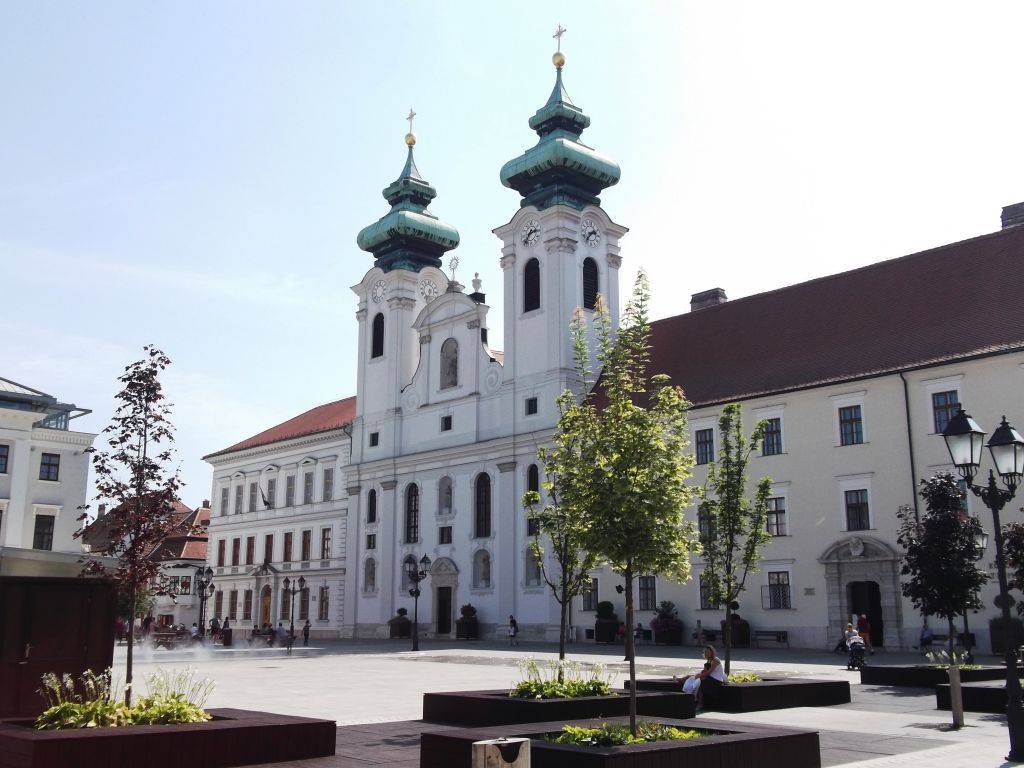
One entire side of Széchenyi Square is taken up by what is now called the Benedictine Buildings. The St. Ignatius Church was covered in scaffolding when we visited. [photo credit ]
The central Széchenyi Square is surrounded by lovely Baroque buildings. One side is dominated by a large block of religious buildings, now referred to as the Benedict Buildings. This belies history as these were originally constructed by Jesuits; after the suppression of the Jesuits Order all were transferred into care of the Benedict monks. Read more about the fate of the Benedict Order below (under the Abbot’s House). Hint: they didn’t fare much better.
The ensemble consists of a 17th century church, the St. Ignatius Church (oldest baroque church of Hungary, but unfortunately under renovation when we visited [2019]), a monastery, and an adjoining school building. Inside there is an interesting Pharmacy Museum, which (among many other things) displays a local invention: the “gastric stapler”.
Other Buildings around Széchenyi Square:
The Esterházy Palace
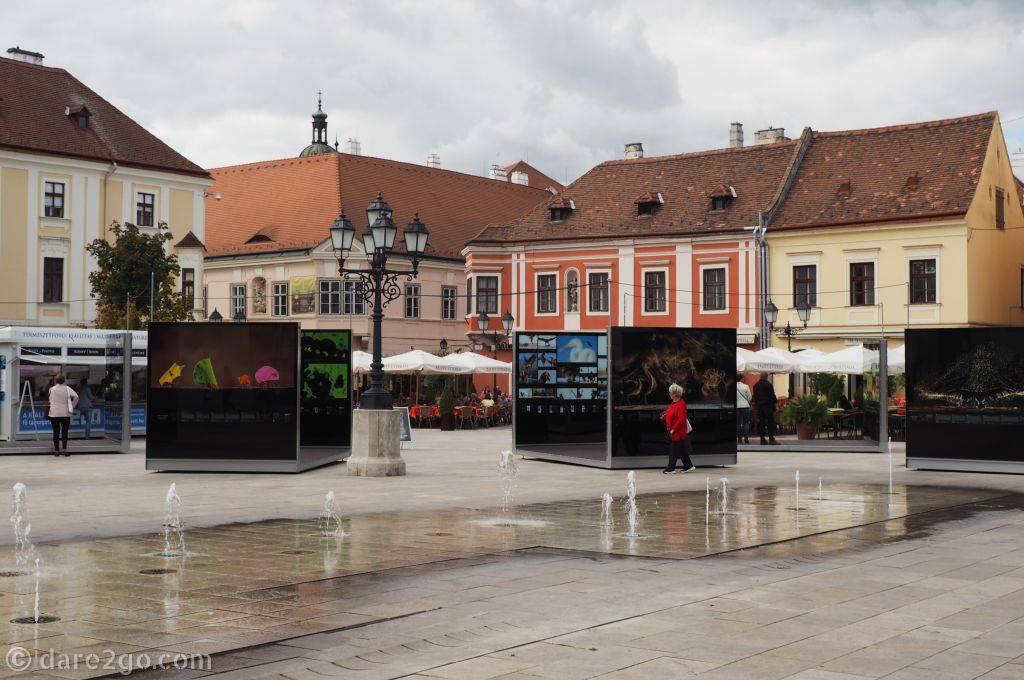
Széchenyi Square with photo exhibition panels by Bence Máté. In the centre of the background, you can see the Esterházy Palace, its bay windows facing the plaza.
This corner building features one of the first floor bay windows so typical for the baroque architecture of Gyor. You will notice them all around the historic centre! On the balcony above the entrance you can see the gilded code of arms of Count Gábor Esterházy, the original owner.
It now houses the city’s most important museum and art gallery, the Flóris Rómer Art and History Museum. Please don’t ask us what you can see inside – it was closed for refurbishment.
The Apátúr House (The Lord Abbot’s House)

The impressive Baroque facade of the Apátúr House, or Lord Abbot’s House, on Széchenyi Square in Győr. It was built for the Benedict Abbot of Pannonhalma in 1741/42.
This beautiful baroque building, distinguished by its religious stone figures and the beautiful sandstone encased bay windows above the main entrance, dates back to 1741/42. It was originally built for the Benedict Abbot of Pannonhalma. When the Benedictine Order was dissolved by Joseph II in 1786, the house fell to the military. It now houses the The János Xántus Museum, named after the Hungarian naturalist from the 19th century.
The Iron Stock House

A row of famous Baroque buildings on Széchenyi Square in Győr: the pale green building with the rounded corners is the Iron Stock House; the one down from it the Apátúr House. On the far right more of the Bence Máté exhibition panels.
The opposite street corner is taken up by the Iron Stock House. Legend tells that in centuries long past every travelling trader would hammer a nail into the wooden corner trade sign – until it became an iron post. Nowadays, a contemporary sculpture reminds passersby of this old custom.
The Bishop’s Palace and Castle
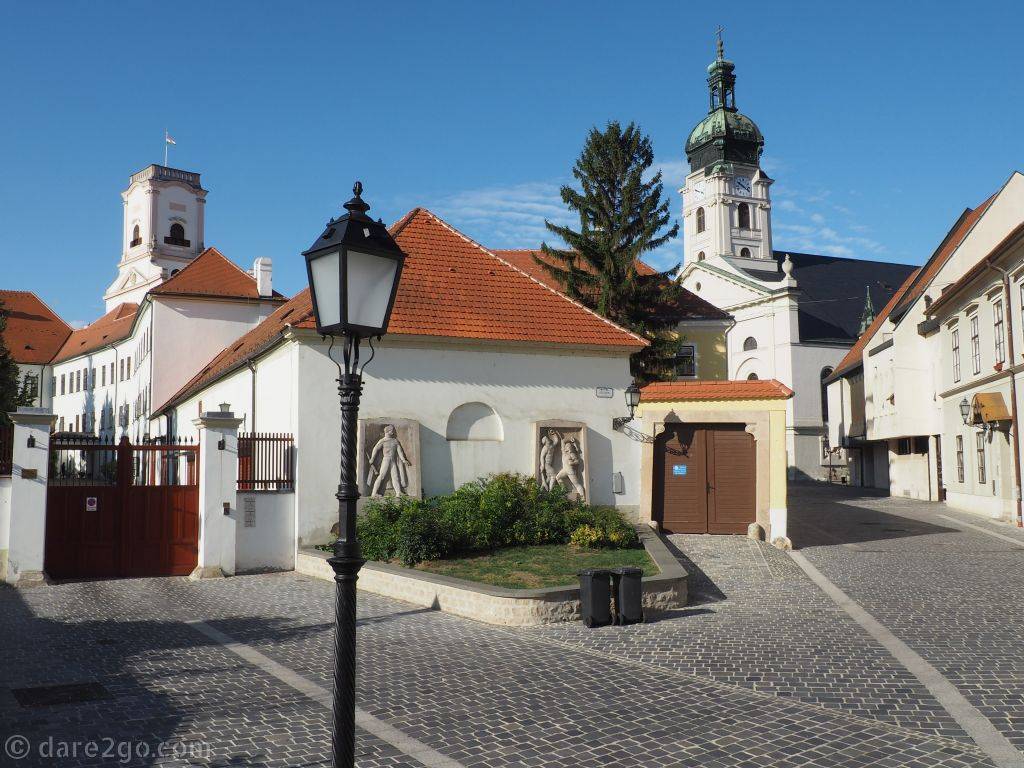
A street view of Győr’s Bishop’s Palace on the left, the Cathedral on the right. This part of town is usually very quiet.
Overlooking the bend where the Rába flows into the Mosoni-Duna River, sits the elevated Bishop’s Palace and Castle. Developed and expanded over many centuries, it’s a mix of Gothic, Renaissance and Baroque architecture. Still in use today, it also houses Hungary’s largest religious collection. For more information see the website [only in Hungarian, but they seem to offer tours in foreign languages!].
You can enter its former residential tower for a view across the roofs of the old town and beyond. Lining the banks of the river around the palace are the last remnants of Gyor’s former ramparts.
Cathedral of the Assumption
Once you have walked up to the Bishop’s Palace you will see the Cathedral of Gyor opposite the entrance to the castle’s tower. Originally built in Roman Style in the 11th century, its current appearance is based on Baroque style architecture from around 1780. Apparently it’s worthwhile seeing the interior. Guess what! It was locked when we passed by.
The Carmelite Church

The baroque Carmelite Church in Győr. On the left you can see the statue of Kisfaludy Karoly.
The Carmelites settled in Győr in 1697. Today their church is one of the city’s main attractions. The saffron painted baroque facade faces a square where one of city’s old town gates (Porta Vienna) once stood. The church was built between 1721 and 1725 after plans by the order’s lay brother Athanasius Wittwer.
In the niches on either side of the main entrance you can see statues of the famous Carmelites, Teresa of Ávila and St John of the Cross. Inside its Black Chapel you will find the famous “Black Mary” statue, dating from 1717. The adjoining monastery, which was completed in 1732, is now a hotel.
Vienna Gate Square [Bécsi Kapu]
![One of the most beautifully decorated bay windows so typical of Győr. This is one of two on the Altabak House on Vienna Gate Square [Bécsi Kapu].](https://dare2go.com/travel/wp-content/uploads/2019/10/Gyor-part-Altabak-House.jpg)
One of the most beautifully decorated bay windows so typical of Győr. This is one of two on the Altabak House on Vienna Gate Square [Bécsi Kapu].
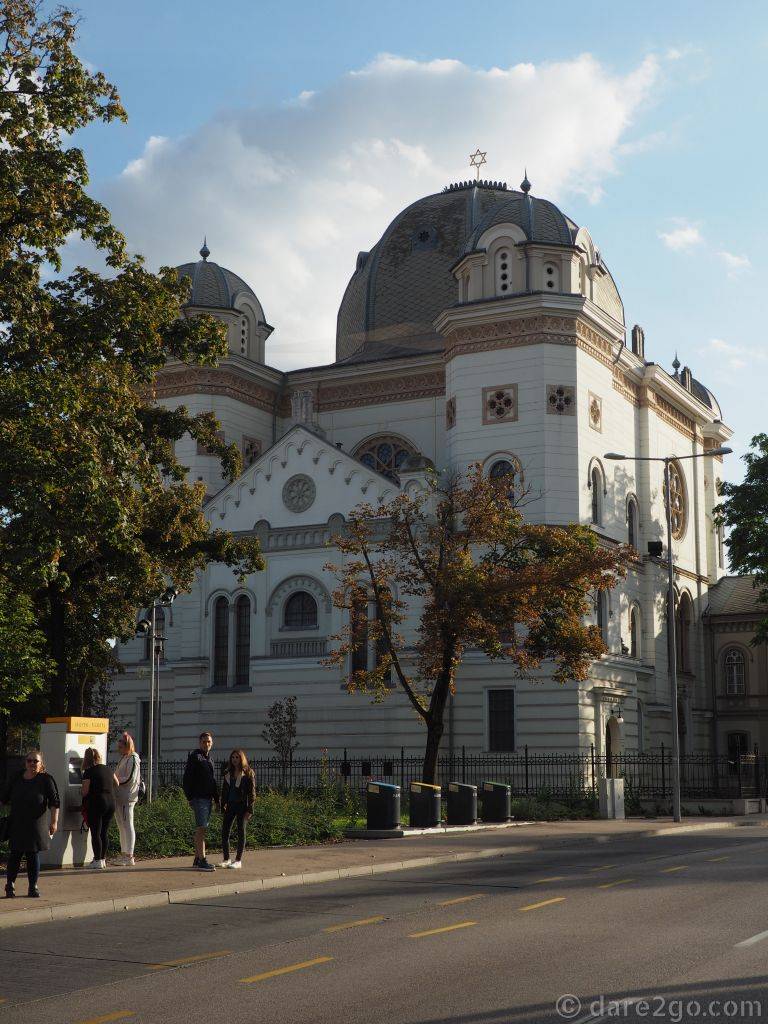
The large, former Jewish Synagogue can be found just outside the historic centre of Győr.(Please scroll down – mentioned below!)
In front of the Carmelite Church, stands a Bronze Statue of Kisfaludy Karoly. Born 1788 in Tét near Gyor, he was a well known Hungarian dramatist and artist . Local anecdote says that the notebook in his hand holds records of citizens’ wrong doings – so be careful!
One corner of the square is taken up by one the oldest baroque houses of the city; the 16th century Altabak House, with its two beautifully decorated corner bay windows.
The National Theatre of Gyor

The National Theatre of Győr was built during the Communist era of Hungary. On the left you can see part of the tile pattern designed by Hungary’s op-artist Victor Vasarely.
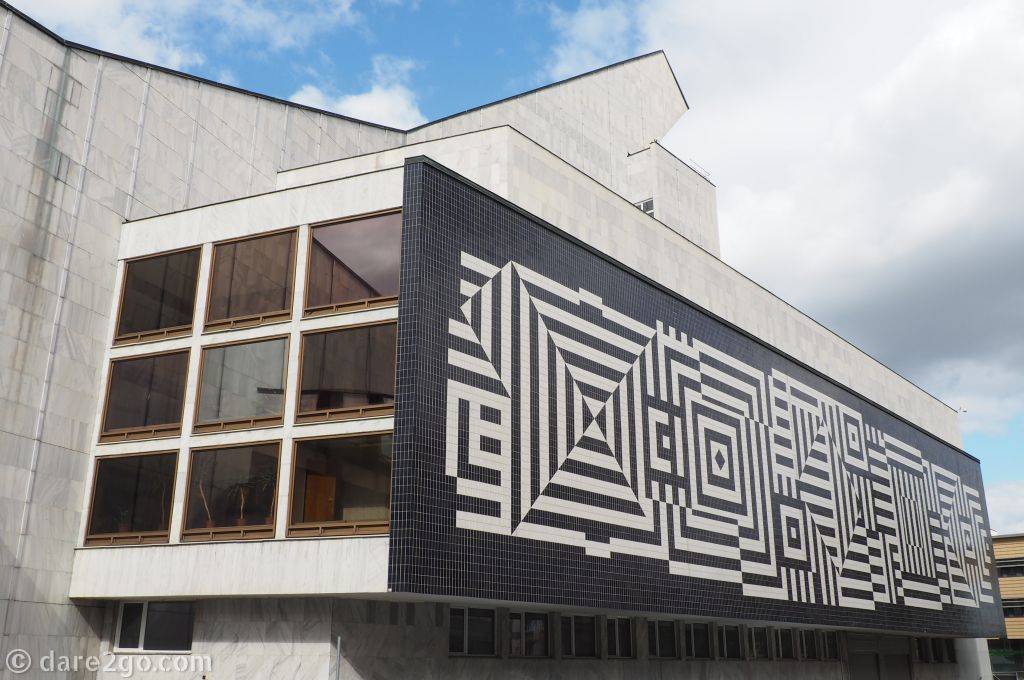
The National Theatre of Győr. Here you can see the tile pattern designed by Hungary’s artist Victor Vasarely. On this side it’s executed in white on a black backround, the opposite side is the same pattern in black on white.
Dating back to the Communist era of Hungary, the National Theatre (formerly known as Kisfaludy Károly Theatre) was inaugurated in November 1978. It’s also home to Gyor’s National Ballet and seats nearly 700 people. From afar it almost looks like a ski-jump ramp, with its roof curving up to the rear and all clad in white marble.
A remarkable feature is the large black and white graphic patterns on both windowless side walls; these were designed by none less than the grandfather of op-art, Hungary’s famous artist Victor Vasarely .
The Former Synagogue
On the far side of the Rába River (from the historic centre) stands the former Synagogue of Győr. It was built in 1860 by the Neolog Faction of the city. The large Romanesque structure is evidence of the former wealth of the Jewish community and served as a model for other synagogues across Europe. Now it is is being used to hold cultural events and to exhibit contemporary art.
This covers the main attractions you should see in the city of Győr. But that’s by no means all – so please read on! You will walk past several of the sights listed below anyhow. Right at the bottom I mention a worthwhile UNESCO World Heritage Site, which is about 20 kilometres from the city.
9 Reasons to Visit Ayacucho in Peru – Now
Ouro Preto: Black Gold and Baroque Opulence
Fountains & Sculptures of Gyor
The pedestrian centre of town was rejuvenated, starting in 1998. It’s now all smoothly paved and adorned with benches (donated by Gyor’s citizens) and several pieces of public art. As mentioned before, many of the sculptures are themed around water; for more detail please see my photo descriptions.
Soda Siphon Fountain
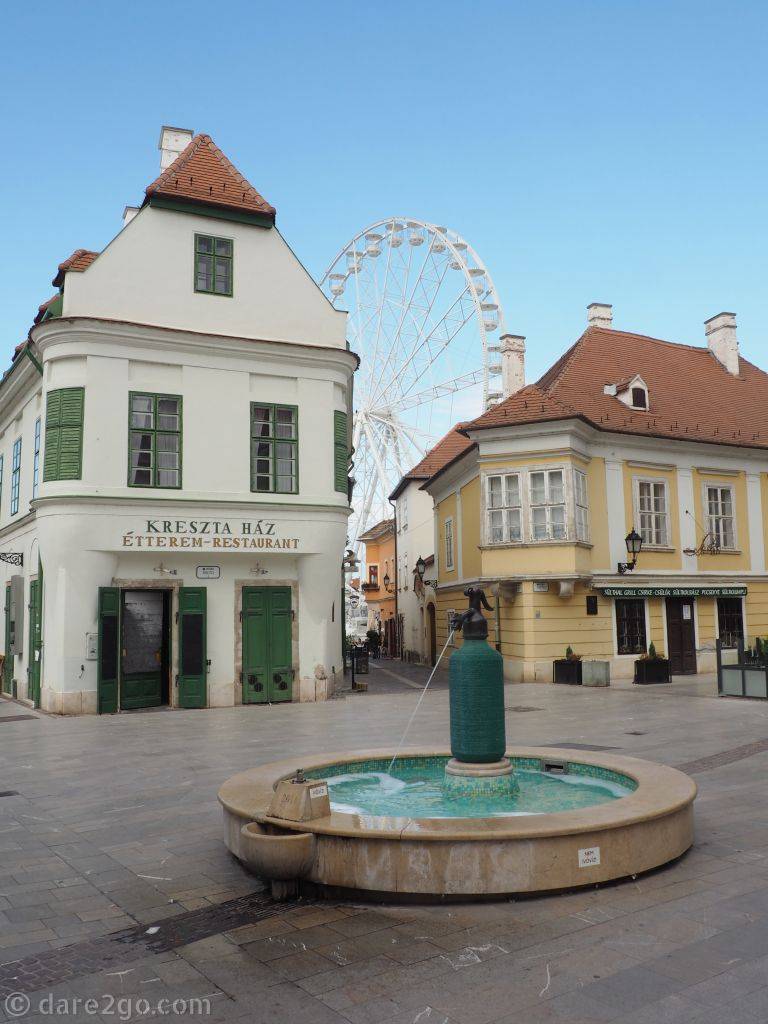
The sculpture of the “soda water siphon” looks more impressive at night, all lit up from the inside of the glass. The “Kreszta Ház” on the left is one of the oldest residential buildings of Győr. We don’t know if the Ferris wheel in the background, standing on Dunakapu Square, is a permanent feature of the city.
An interesting invention that originates in Gyor, is the soda syphon. In 1813, Ányos Jedlik, a monk and teacher at the Benedict school, patented the industrial production of carbonated water. Later he also discovered that mixing soda water with wine made a refreshing drink and thus the famous “Wine Spritzer”, locally called Fröccs , also has its origin in Gyor. A special fountain is dedicated to the old-fashioned soda syphon, and the tourist information has a collection of ancient soda syphons on display.
Sculpture of the Iron Rooster
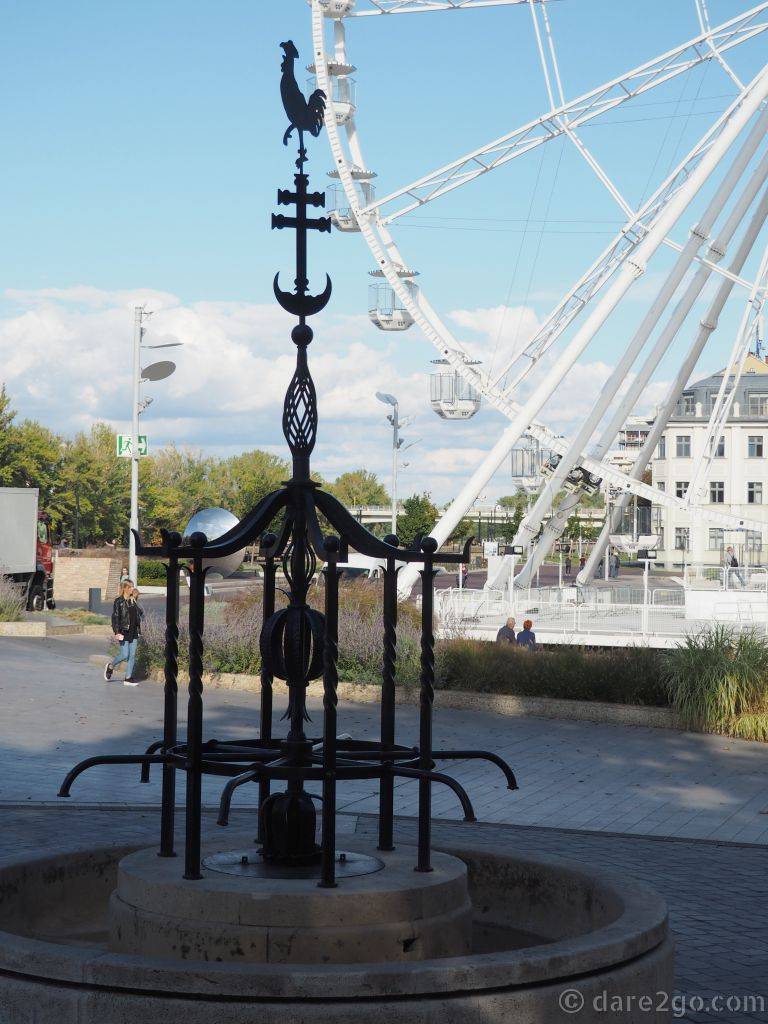
The sculpture of the Iron Rooster – erected in commemoration of another curious tale from Győr – find it in the text below.
As I told you before, Győr has a wealth of local stories, legends and anecdotes. Here’s another sculpture dedicated to one!
When the town was occupied by the Ottomans, they erected an iron rooster as a weathervane. They swore to the suffering locals that they would stay forever; unless the iron rooster crowed and the Turkish half-moon beneath turned into a full moon. Only then would they relinquish the castle and town to the Hungarians.
This prophecy touched a young local shoemaker apprentice so deeply that he took his trumpet and climbed on top of the castle walls in the dark of night. At dawn he imitated the crow of a rooster on his instrument and scared the bejeezus out of the Turks, who abandoned the city soon after.
More sculptures and fountains from Gyor. Please click the thumbnails below for a larger photo with description.
- The fountain/sculpture of the “Boatman” is a reminder of the last flood in Győr. A naked man paddles a small flat-bottomed boat.
- This sculpture in a fountain base shows a tall (religious?) man with a small dragon at his feet. We don’t know the name of this art piece.
- The sculpture of Ányos Jedlik and Gergely Czuczor stands just off Széchenyi Square. These cousins, both Benedict monks, and both came to fame in their fields. Ányos Jedlik was a teacher and inventor; it’s claimed that (beside carbonated water) he also invented the first electric motor, although Siemens developed the first commercial version.
- The tall marble column of St. Mary was erected on Széchenyi Square in 1686 to commemorate Győr’s liberation from the Turkish occupation.
- Győr’s latest sculpture is this large convex mirror, called “Pulse”. It reflects everything around Dunakapu Square on the bank of the Mosoni-Duna River.
- The religious “Ark of the Covenant” sculpture was donated by the Austro-Hungarian emperor to Győr in 1731. The preceding story in another funny anecdote of the city: a soldier accused of bigamy searched refuge in the Jesuit monastery. His pursuers then blockaded the building, leaving him no way out. So he disguised himself as an altar boy and carried the Holy Sacrament during a procession. Of course somebody recognised him and, in the following commotion, the Holy Sacrament was dropped and shattered into little pieces.
- A fountain of clear glass sheets, embellished with colourful glass pieces, stands at the entrance of the Vienna Gate Square into the historic centre of Győr.
- This famous Golden Ship used to be the trade sign of a goldsmith in Győr. If you look around the side streets near it, you find many more old-fashioned trade signs hanging above shop doors.
Try the Local Speciality: Lángos
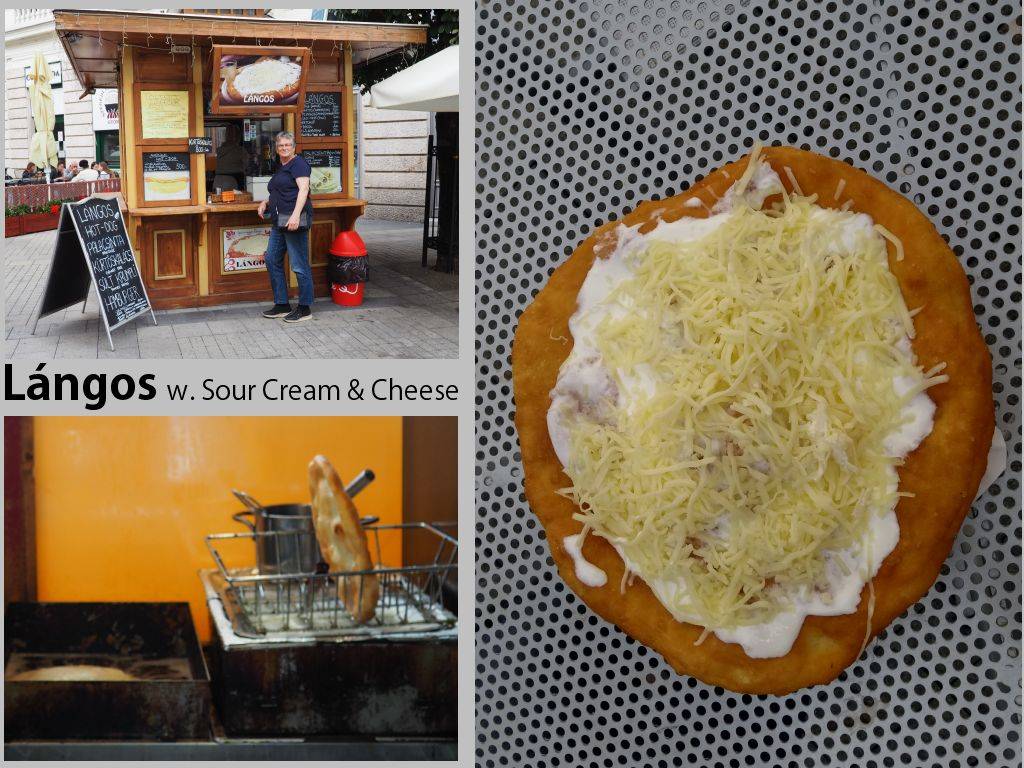
A Lángos is a flat disk of dough, deep fried and served with various toppings – a typical snack in Hungary.
If you get hungry from all the sight-seeing, you should try the local speciality called Lángos.
Some call it the Hungarian Pizza, but that isn’t really a fitting description. A Lángos is a flat disk of dough, deep fried and served with various toppings. The most popular version, which we tried, is topped with sour cream and grated cheese. They are very filling. You can buy them from street stalls around town; most have tables and chairs where you can eat sitting down. Be warned though: Lángos aren’t for people who require a low-fat diet!
Audi Hungaria Visitor Centre
Some of you might have been wondering, all through this article, how a medium sized city in a former Communist country can afford all these splendid public spaces and facilities. The city even offers free public bus services. My guess is that the large Audi factory (and other manufacturers alongside) brings in some wealth.
Others (owners of specific Audi car models) might have thought all along that the name of the city sounds somewhat familiar. Their vehicle probably originates from Gyor.
The factory is open for free public tours in Hungarian, German and English. You have to register in advance at the Audi website .
Pannonhalma Archabbey

The enormous Pannonhalma Archabbey as seen from the village of Ámánd. This Benedict monastery dates back to 996, most current buildings are either Gothic or Baroque style.
A little over 20 kilometres from Gyor is the World Heritage listed Archabbey of Pannonhalma. First settled by the Benedictines in 996, the abbey went through some turbulent history. The Benedict Order had to abandon the monastery several times: first when the Turks invaded; then in 1786 the Holy Roman Emperor Joseph II banned the order; and finally in 1945, the Communists nationalised all church properties and expelled the monks.
The monks could only return after 1989. Fittingly, exactly 1000 years after its founding, the Pannonhalma Archabbey was added to the World Heritage List in 1996 . Most of its current buildings are either in Gothic or Baroque style. Now the order lives from viticulture, their boarding school, and tourists.
Rába Quelle Thermal Bath and Spa
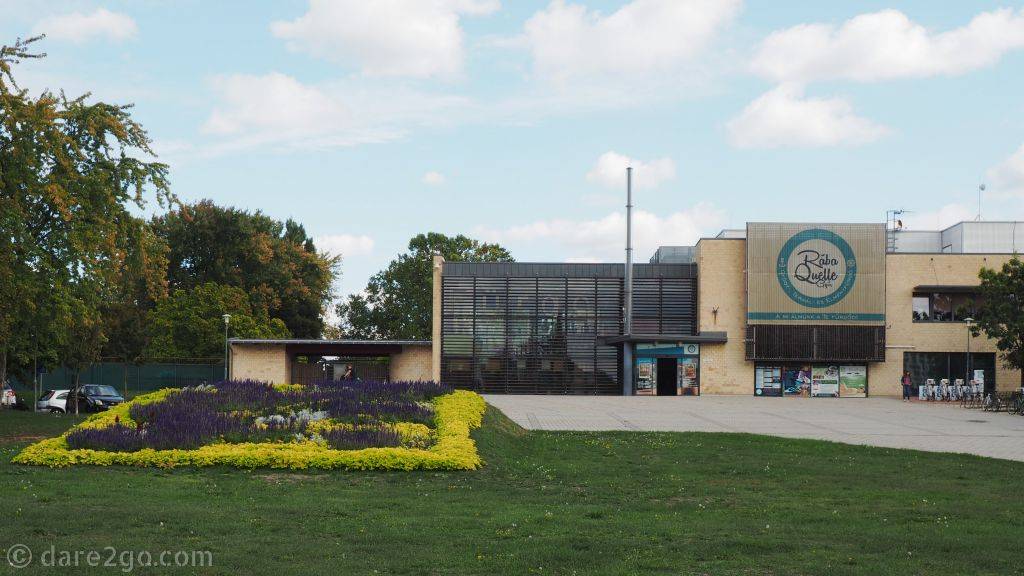
The Rába Quelle Thermal Bath in Győr is just outside the historic town centre. The size of the entire complex invites you to spend a full wellness day in this spa.
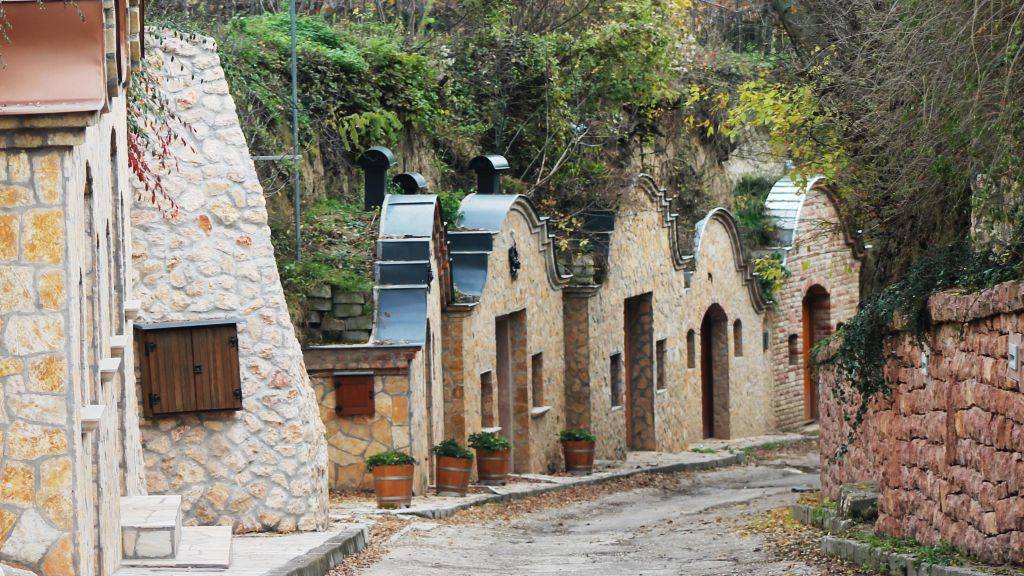
Hungary has a fairly unique style of wine cellars. They are built into a hill, covered with soil. Only in the front is a small, often cute, house for the pressing. This row of cellars is in Nyúl, on the road to the Pannonhalma Archabbey.
Within walking distance of the historic centre you will find the Rába Quelle Thermal Bath and Spa. It’s a chlorine-free thermal bath with indoor and outdoor pools, two water-slides, and many attractive offerings to improve your well-being. More information at the spa’s website .
It is easy to visit Gyor
So now that you have heard about Győr (or better, have read) will you visit this lovely city?
Let’s make it a little more tempting for you: Gyor is really easy to reach from several major cities, in 3 countries. It sits right in the middle of a triangle formed by Vienna (Austria) to the west, Budapest (Hungary) to the east, and Bratislava (Slovakia) to the north. It’s just 80 kilometres by road from Bratislava. Don’t forget that Central Europe has open country borders!
Gyor would make for a nice escape from any of these much bigger and and more popular cities! You could even base yourself here and visit Bratislava on a day trip… The region offers many more experiences, like the wine growing region of Nyúl with its very unique rustic stone cellars (see photo above).
The city also has a long established zoo, called Xantus János Állatkert. We don’t want to encourage any keeping of animals in captivity, hence we didn’t give it a dedicated listing. If you are interested please visit the zoo’s website for more detail and prices.
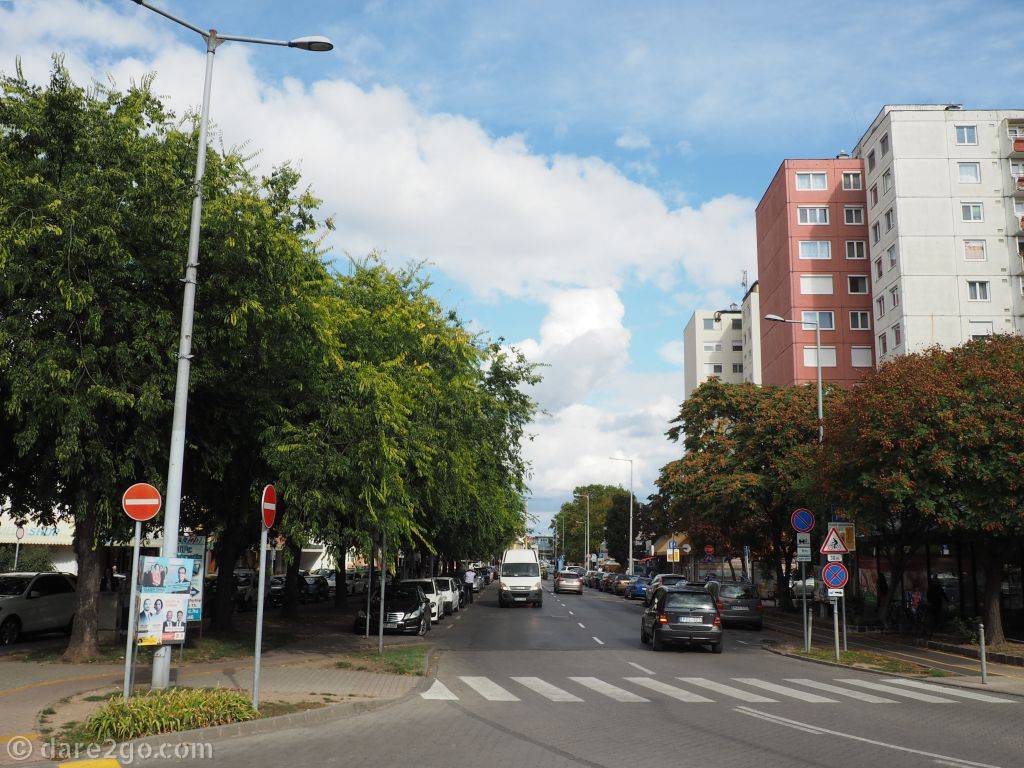
One thing we liked about Győr: it’s green and has a lot of public open spaces, even outside the historic old town.
To encourage you to visit many of the city’s and surrounding sights Gyor offers a special tourist card, the GyőrCard . You can buy 4 different versions, each in plastic (physical card) or as a virtual card for your smart phone. There’s a choice of a 24-hour card and a 48-hour card, available as an adult or a child version for different prices. Please visit the website linked above to decide if this would be of value to you (we didn’t buy the card because some attractions were closed at the time of our visit).
This book is for travellers who are more interested in the sights than recommendations for restaurants or hotels.
General Hungary Travel Information
Hungary is part of the “open border” Schengen Region of the European Union; the normal Schengen Travel and Visa rules apply and you won’t get checked when entering from Austria or Slovakia (you will be on the southern border with Croatia, a Non-Schengen-Country).
Like its neighbours to the north (Slovakia and the Czech Republic), Hungary has kept its national currency, the Hungarian Forint [HUF] . You can find money changers almost everywhere, and most don’t charge a commission on cash transactions. Győr is only 55 kilometres from the border with Austria, part of Euro zone. Therefore Euro payments are widely accepted throughout the city of Gyor, usually for a fair exchange rate. Only the parking meters require payment in Forint.
Please share this post on Pinterest to show your friends or to remember for later:
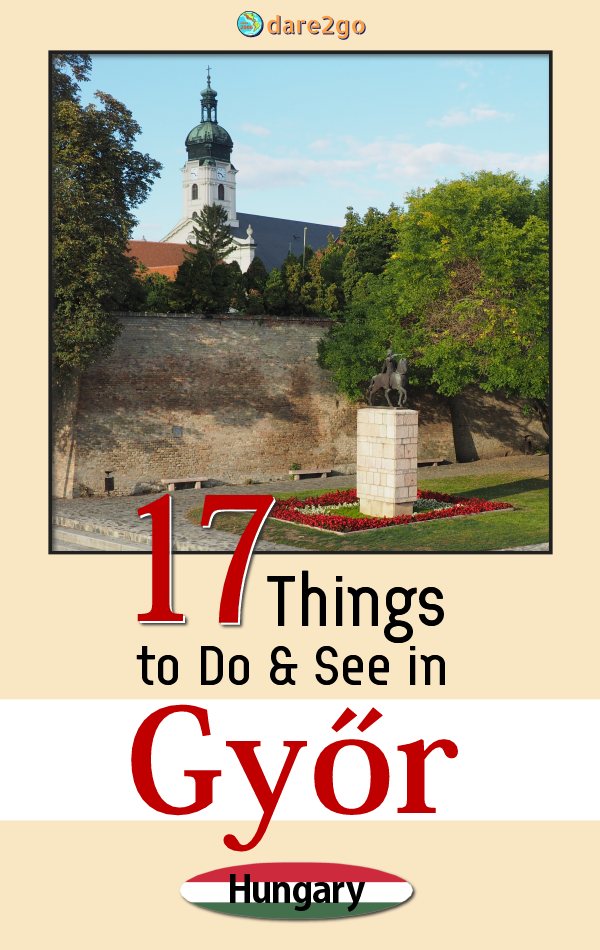

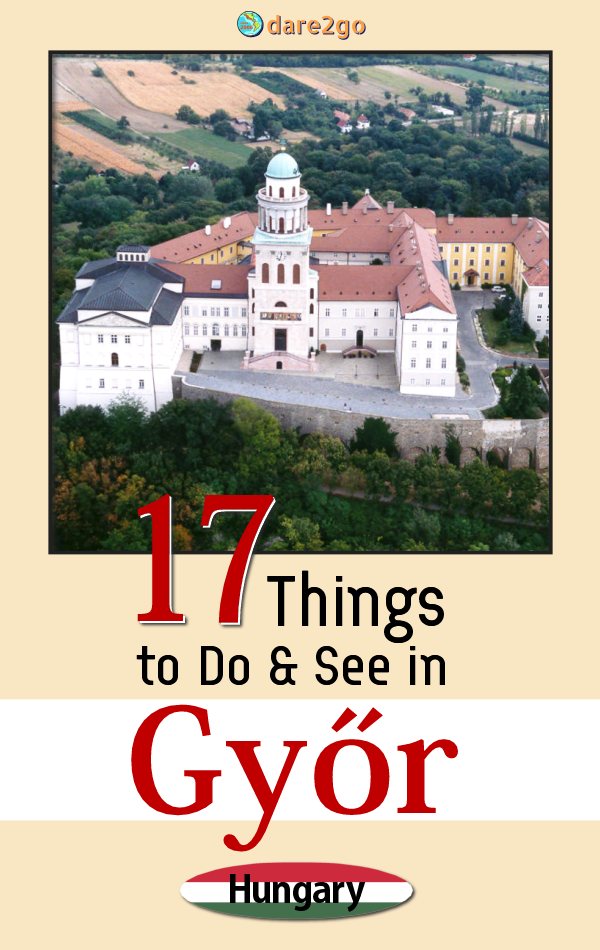
- Pinterest1.1K
- Facebook522
- Twitter4
- Reddit0
- Flipboard1
- Email4
- Buffer15
- 1.7Kshares
- Like
- Digg
- Del
- Tumblr
- VKontakte
- Buffer
- Love This
- Odnoklassniki
- Meneame
- Blogger
- Amazon
- Yahoo Mail
- Gmail
- AOL
- Newsvine
- HackerNews
- Evernote
- MySpace
- Mail.ru
- Viadeo
- Line
- Comments
- Yummly
- SMS
- Viber
- Telegram
- Subscribe
- Skype
- Facebook Messenger
- Kakao
- LiveJournal
- Yammer
- Edgar
- Fintel
- Mix
- Instapaper
- Copy Link








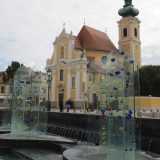
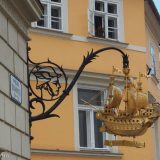

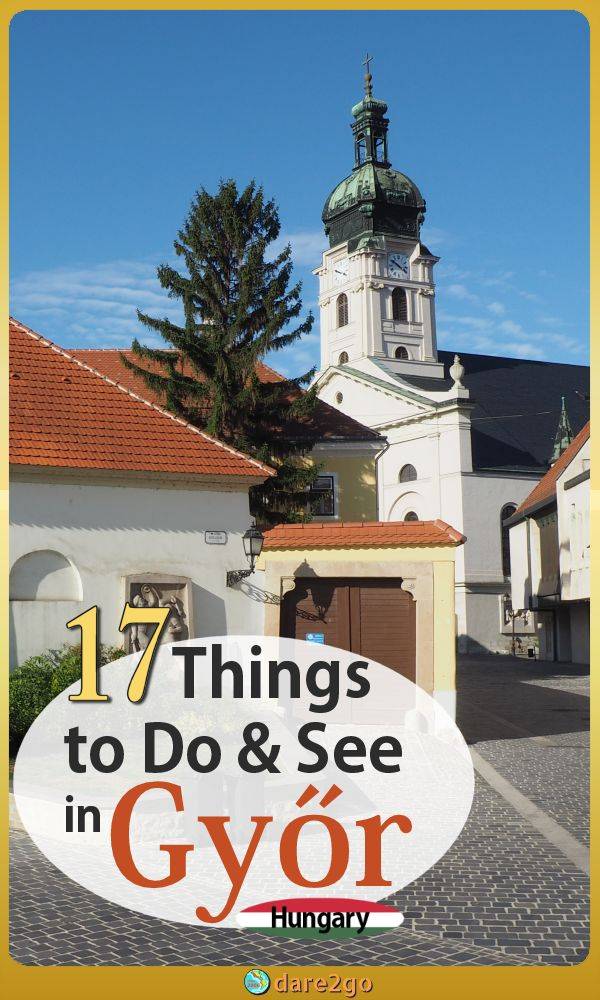





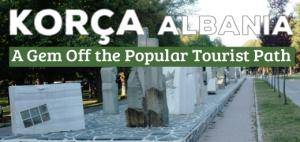






I came across your blog AFTER I have visited Gyor, like you, with no preconceptions or expectations, of the place. Just wanted to say thank you for the most complete information about Gyor I found while reading more about the amazing place after being spellbound by it.
Thank you very much for this compliment! Yes, we still have fond memories of this lovely (undiscovered) town.
I’ve been to Gyor many times as a child, because my grandparents used to live in Komarno. It was nice reading your article and remember the city I visited a long long time ago :)
I’ve only been to Budapest, but would love to get to Győr next time. So much history and beautiful architecture!
Do go! You won’t be disappointed.
What a gem. Loved reading the bit of history (burnt down the town!) Love the architecture and Jesuit past. Would love a long day in the thermal spring too.
Yeah, we really loved all the historic tales we found out about in Gyor.
An interesting read as we are heading to Hungary this coming weekend. Will do Budapest and then head to Vienna for a first-time visitor whirlwind stop, but this is definitely worth keeping in mind for a return visit.
Do so! It’s never a good idea to travel under time restrains as you miss so much. We love to explore out-of-the-way places like Győr, which are quieter than main cities. I wish you a good time and dry weather for your trip.